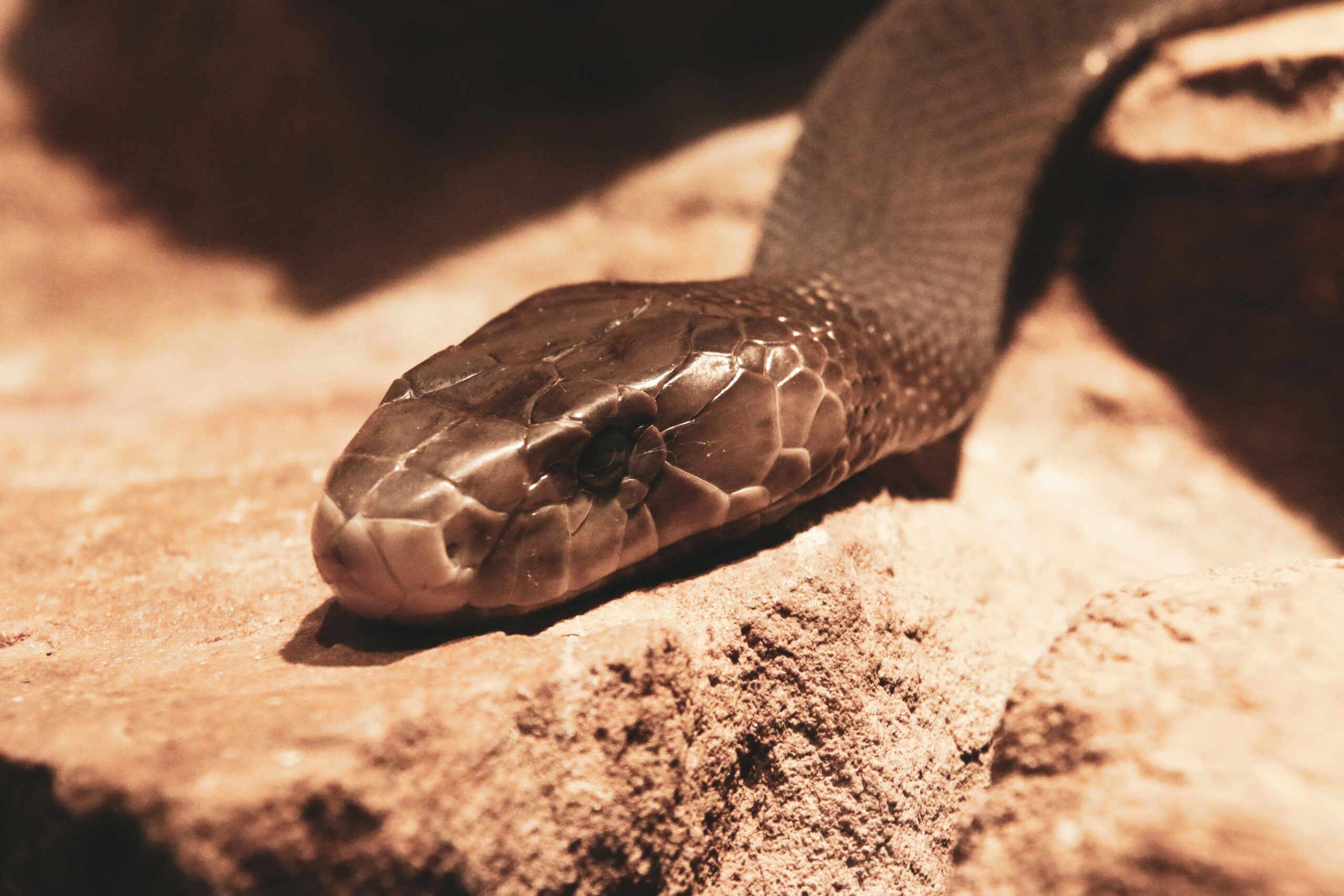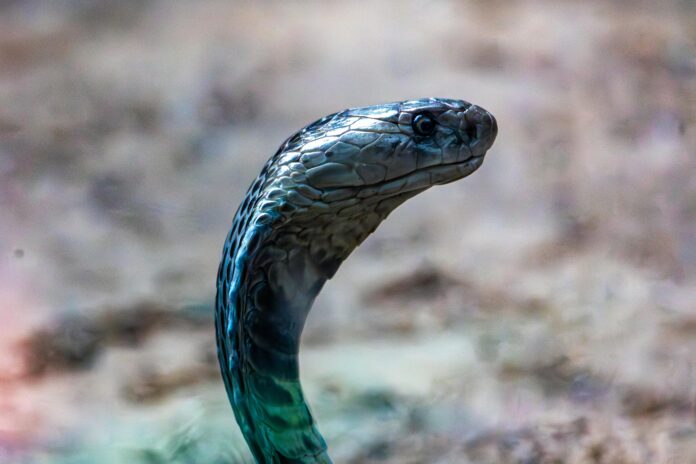Summary: The Black Mamba is one of the most feared and respected snakes in the world due to its extreme speed, potent venom, and aggressive reputation. Native to sub-Saharan Africa, it is the continent’s longest venomous snake, capable of growing over 14 feet. Despite its name, the Black Mamba is actually olive to grayish-brown in color, with a dark, inky mouth that gives it its name. Known for its neurotoxic venom, a bite can be fatal if not treated promptly, making timely medical intervention critical. However, the Black Mamba is shy by nature and will usually avoid human contact unless threatened.
Among the pantheon of deadly creatures that roam the wilds of Africa, the Black Mamba (Dendroaspis polylepis) stands out as one of the most feared and respected. Known for its astonishing speed, potent venom, and reputation for aggression, this serpent has fascinated and frightened both locals and wildlife enthusiasts for generations. Despite its fearsome image, the Black Mamba is a highly evolved predator, well-adapted to the ecosystems it inhabits. This article delves into the biology, behavior, and ecological significance of the Black Mamba, as well as dispelling some of the myths that have elevated it to near-legendary status.
Physical Characteristics
Despite its ominous name, the Black Mamba is not black on the outside. Its skin color typically ranges from olive-green to grey or even light brown, with a pale underbelly. The term “black” refers to the inky black coloration inside its mouth, which it displays as a warning when threatened. It is one of the longest venomous snakes in the world, with adults commonly reaching lengths of 8 to 10 feet (2.5 to 3 meters), and some specimens exceeding 14 feet (4.3 meters). Its body is sleek and muscular, allowing it to move swiftly and efficiently through its environment. The Black Mamba is also notable for its coffin-shaped head and piercing eyes, which enhance its menacing appearance.
Habitat and Distribution
The Black Mamba is native to sub-Saharan Africa, thriving in a variety of environments including savannas, dry woodlands, scrublands, and rocky hills. It prefers warm, arid regions and typically avoids dense forests or extremely humid environments. The snake often makes its home in hollow trees, abandoned termite mounds, rocky crevices, or even burrows left behind by other animals. Countries where the Black Mamba is commonly found include South Africa, Kenya, Tanzania, Uganda, Zimbabwe, Mozambique, and Ethiopia. Due to its adaptability, it is one of the most widespread and successful snake species on the continent.

Hunting Style
The Black Mamba is diurnal, meaning it is active during the day. It is a solitary and highly territorial snake, usually only coming into contact with others during mating season. Known as the fastest snake in the world, it can move at speeds of up to 12 miles per hour (19 km/h) over short distances. This speed, combined with its agility and sharp eyesight, makes it an effective predator.
When hunting, the Black Mamba uses stealth to approach its prey, which typically includes small mammals such as rodents, birds, and even bats. Once within striking range, it delivers a series of rapid bites, injecting a neurotoxic venom that immobilizes the prey almost instantly. It then waits for the venom to take effect before swallowing the prey whole.
Venom and Human Danger
One of the most alarming aspects of the Black Mamba is its extremely potent venom. A single bite can deliver enough neurotoxin to kill several adult humans. The venom works quickly, affecting the nervous system and causing symptoms such as dizziness, blurred vision, difficulty breathing, paralysis, and eventually death if untreated. In the past, before the widespread availability of antivenom, bites from Black Mambas were nearly always fatal, often within 30 minutes.
Today, with access to medical facilities and effective antivenoms, fatality rates have dropped significantly. However, time is of the essence. Immediate medical attention is crucial, and any delay can drastically reduce chances of survival. Despite its lethal capability, the Black Mamba does not attack humans unprovoked. Most bites occur when the snake feels trapped or cornered.
Myths and Misconceptions
The Black Mamba has inspired numerous myths, largely due to its striking appearance and deadly reputation. One common myth is that the Black Mamba will chase humans, a behavior that has never been scientifically verified. In reality, like most snakes, it prefers to avoid confrontation and will only stand its ground when it feels threatened.
Another misconception is that every bite is instantly fatal. While untreated bites are extremely dangerous, prompt medical treatment significantly improves survival rates. It’s also worth noting that the Black Mamba, while defensive, is not as unpredictable or aggressive as some stories suggest. It generally delivers a warning display raising its head, opening its mouth, and hissing before striking.
Reproduction and Life Cycle
Mating season for the Black Mamba usually occurs during the spring and summer months. Males will engage in wrestling matches to compete for a female, but these encounters are rarely lethal. After mating, the female lays a clutch of 6 to 25 eggs in a warm, hidden location such as a burrow or decomposing vegetation, which provides natural incubation heat.
The eggs hatch after about three months, and the young snakes are immediately independent. Hatchlings are fully venomous from birth and must fend for themselves from day one. Despite this, mortality among juveniles is high due to predators and environmental threats.
Safety Tips in Black Mamba Regions
If you’re traveling or living in an area known to be inhabited by Black Mambas, it’s essential to take precautions:
Stay alert when walking through tall grass or bushland.
Avoid reaching into holes, crevices, or hollow logs where snakes may hide.
Do not attempt to kill or capture a Black Mambait increases the likelihood of a defensive bite.
Wear boots and long pants in snake-prone areas.
Seek immediate medical help if bitten and try to remain calm and still to slow the venom’s spread.
Being informed and cautious is the best defense against unwanted encounters.
Frequently Asked Questions
Why is it called the Black Mamba?
The Black Mamba gets its name from the dark black coloration inside its mouth, not from its skin color.
Where do Black Mambas live?
Black Mambas are native to sub-Saharan Africa and are commonly found in savannas, rocky hills, and open woodlands.
How venomous is the Black Mamba?
The Black Mamba’s venom is extremely potent and neurotoxic, potentially causing death within hours without antivenom.
Can a Black Mamba kill a human?
Yes, without medical treatment, a Black Mamba bite is often fatal due to rapid paralysis and respiratory failure.
How fast can a Black Mamba move?
Black Mambas can slither at speeds of up to 12 miles per hour (19 km/h), making them one of the fastest snakes.
What does a Black Mamba eat?
Black Mambas primarily feed on birds, small mammals, and occasionally other reptiles.
Is the Black Mamba aggressive?
Although it has an aggressive reputation, the Black Mamba is actually shy and prefers to flee rather than fight when threatened.
How long do Black Mambas live?
In the wild, Black Mambas can live up to 11 years, and even longer in captivity.
How long can a Black Mamba grow?
Black Mambas can grow up to 14 feet (4.3 meters) long, making them Africa’s longest venomous snake.
Can the Black Mamba be found in cities?
Black Mambas generally avoid human settlements, but they may occasionally enter rural homes or outbuildings in search of food or shelter.

